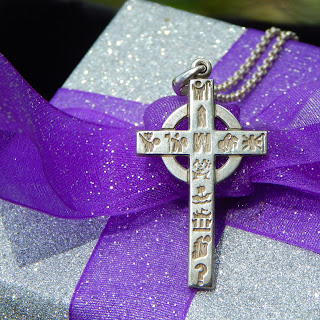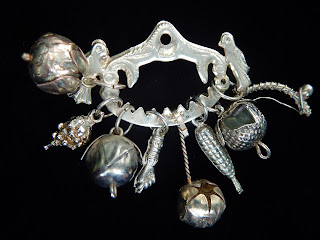 |
ayquebella.com
|
This beautiful History of Ireland Celtic cross pendant was made in Ireland and draws on the ancient traditions of Irish storytelling, Irish metalwork and on Ireland’s rich heritage. This delightful and classic pendant encapsulates thousands of years of Irish history in 12 iconic symbols, evocative of the carvings on Celtic High Crosses which were a distinctive expression of Irish Christian art and storytelling during medieval times. But the beauty of the design is in the story the 12 symbols tell. This is a thoughtful and provocative collection of symbols, each depicting different stages of Irish history, from Saint Patrick’s arrival in Ireland to a question mark to decipher what the future holds. (See full description of all 12 symbols below.)
 |
ayquebella.com
|
A generous section on the back of this gorgeous and handcrafted cross pendant is left blank for engraving a name, a birthdate or perhaps, Éirinn go Brách. Included with this stunning pendant is an 18-inch rolo chain necklace to allow for immediate wear or gift-giving. This wonderful pendant shows a few minor signs of wear and aging, consistent with its age, and are undetectable to the casual observer.
 |
| ayquebella.com |
 |
ayquebella.com
|
- Signature Hallmarks (Pendant): SD with Irish harp stamp .925 – Shamrock stamp with DMH - MADE IN IRELAND
- Signed Hallmark (Rolo Chain): .925 Italy
- Metal: Sterling Silver
- Finish: Undisturbed, natural patina (may require a light cleaning, if desired)
- Condition: Excellent vintage
- Weight (Total): 5.0 g
- Bale (Pendant): Solid, pinched bale
- Clasp (Chain): Spring-ring
- Measurements (Pendant): Approx. 1 3/8” L x 3/4” W (plus addt’l 3/16” long for bale)
- Measurements (Chain): 18” L
- Gift box and wrapping may vary.
 |
ayquebella.com
|
FULL DESCRIPTION OF SYMBOLS:
- St. Patrick - Ireland's patron saint who changed Ireland’s course in the 5th Century, converting the Irish to Christianity.
- The Round Towers - From the 6th Century onwards, Christian monks built the Round Towers as the Irish embraced Christianity. Originally bell-towers, they were soon needed for storage and refuge during invasion.
- Viking Warrior - From the 9th to the 11th Century, Vikings repeatedly attacked the Irish coast. Defeated by Brian Boru at the Battle of Clontarf in 1014, the Norsemen retained Dublin, Wexford, Waterford, Cork and Limerick.
- Norman Soldier - The 12th Century invaders were Norman, Flemish and Norman-Welsh, led by Henry Angevin, Henry II of England.
- Dublin Castle - Built on the order of King John “for the custody of our treasure... the administration of justice and if need be for the defense of the city” between 1204 and 1224. It became the center of Anglo-Normans, and later, English power, provoking hostility from native Irish.
- King William - Protestant King William defeated his father-in-law, Catholic James II at the Battle of the Boyne in 1690. The victory assured a Protestant ascendancy, lasting for more than two centuries.
- The Union Jack - In 1800, the Irish Parliament was abolished for direct rule from London. The cross of St. Patrick was added to the Union Jack. The unpopular union was forced through with fears of a French invasion throughout Ireland.
- The Great Famine - The potato crop failed catastrophically in the 1840s. The London government failed to act and a crippling famine ensued. Over 1 million died and another million scattered around the globe. (Yes, I know...I know..this one leads to many discussions, debates and arguments...)
- The Emigrant Ship - The Irish were reluctant emigrants before the famine. In the decades after, Irish emigration rose dramatically, with most going to the United States and Canada.
- The GPO - In 1916, The Republic of Ireland was proclaimed from the General Post Office during the Easter Rising. It was a military failure but the execution of ‘The Rising’ leaders provoked great anger, igniting the War of Independence.
- Partition - The 1921 treaty ended the War of Independence. Six of Ulster's nine counties became “Northern Ireland,” a province of the UK. The 26 remaining counties became “The Irish Free State” and in 1948 the “The Republic of Ireland.”
- Domine Quō Vādis - The question mark symbolizes the unknown future of Ireland.
Order in which the symbols appear on the pendant:
Center, Top to Bottom: St. Patrick, The Round Towers, Dublin Castle, The Great Famine, The Emigrant Ship, The GPO, Partition, Domine Quō Vādis
Left to Right: Viking Warrior, Norman Soldier, Dublin Castle, King William, The Union Jack
 |
ayquebella.com
|
Love One Another ~ Bella Morena









